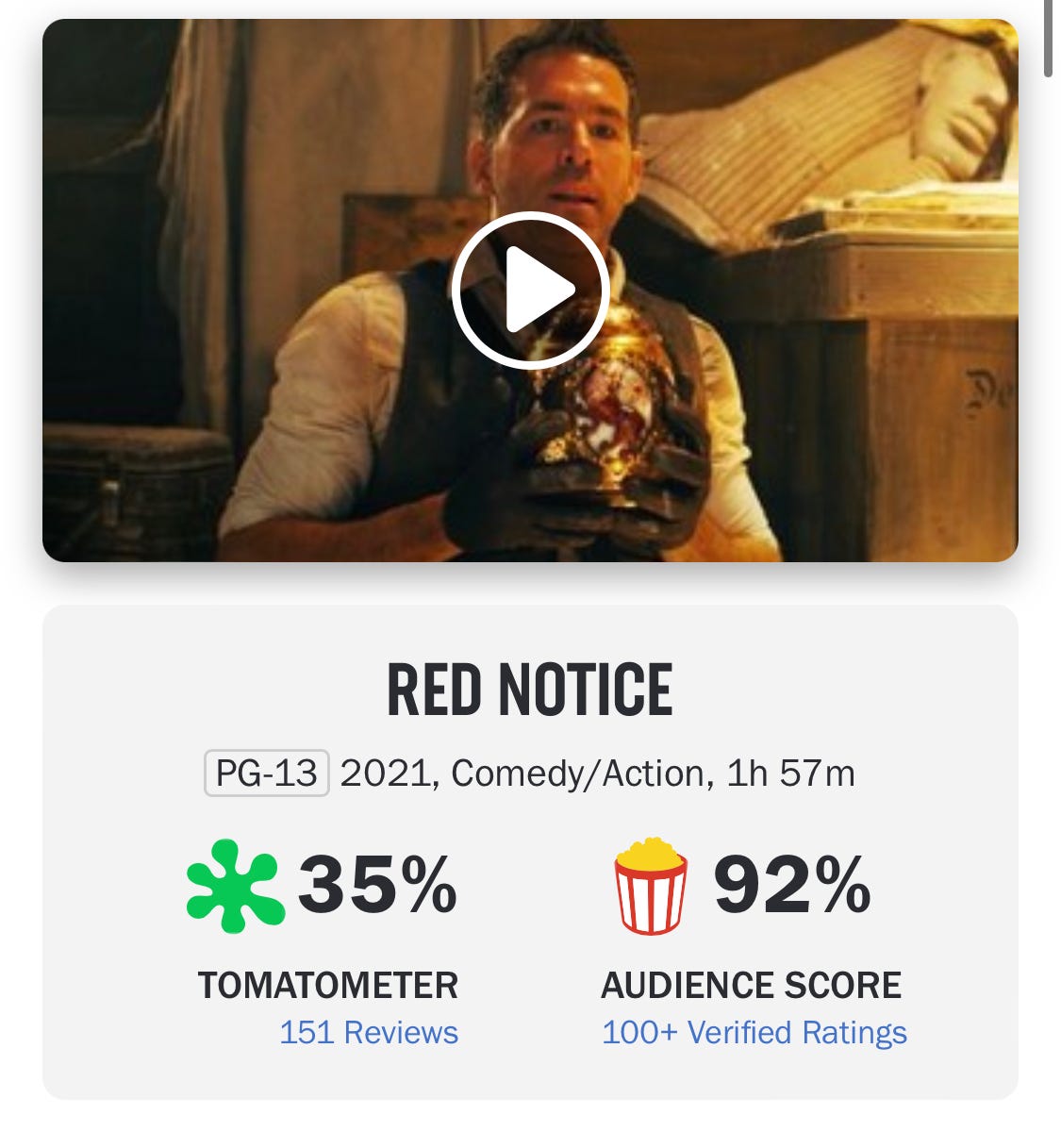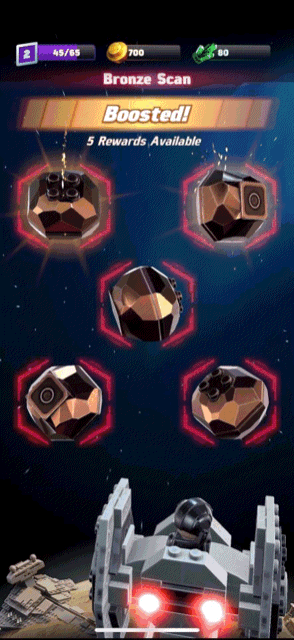LEGO Star Wars
A short time ago in a nearly ubiquitous intellectual property
Too Big to Fail?
This week’s review is about the two LEGO Star Wars games on Apple Arcade. But before we jump in, I want to talk about another set of franchises that are too big to fail: the Rock and Ryan Reynolds cinematic universes, most recently found in Red Notice.
The Rotten Tomatoes ratio on Red Notice is something to behold.
It’s easy, as someone who spends way too much time reading and thinking about media, to jump to big conclusions that point to the consolidation of the movie industry and the fact that it’s a winner-take-all economic model for most content. It’s easy to end up with a plea to “buy indie”, which is the nerd equivalent of buying local.
It’s important to remember that for people living or hobbying in a medium, our expectations are so divorced from other peoples’. Something that is basically fine to a normal person can be extremely disappointing to an “auter” or “expert”. This isn’t to clown on one or the other, but to point out that part of the point of critique is bridging the gap between those worlds. It’s hard to bridge that gap if most critiques are “actually you shouldn’t have liked this”.
I think it’s ok to look at media created in these worlds and say, these are basically ok, but also ask if it’s fair to expect more. Star Wars (and maybe LEGO) is one of those brands that feels too big to fail. And the two games I’m reviewing, LEGO Star Wars Battle and LEGO Star Wars Castaways are Star Wars-y takes on popular genres. It would be easy to look at them both as crass attempts to capitalize on a brand, but I’m going to try to take step further and see what lands beneath the surface.
To The Battle
LEGO Star Wars Battle was initially planned as a freemium mobile title, disappeared and apparently revived to join the ranks of Apple Arcade.
Battle is a mobile-first tactical strategy game where you try to destroy your enemy towers by deploying units before they can do the same to you.
It seems to be based on Clash Royale the popular second release by mobile powerhouse Supercell. The game is a mashup of a trading card game and competitive tower defense. Each match takes about two minutes. You play cards by spend a certain amount of mana (that you accrue over time) and then watch as they move across the field battling the opponents. The game either ends after 2 minutes with the player owning more towers winning, or it ends when one player has destroyed the other player’s home base. In each game you put together a “deck” of 8 types of cards with different strengths and weaknesses that you’ll use to defeat your opponent.
What you typically want in a two player game is a series of questions and answers. Basically the opponent poses a problem, you answer it, then you pose your own. That back and forth creates the flow of the game. Card battlers like this do so with the different costs and strengths of characters, as well as the randomness of the deal of the cards. You grow into the game as you understand how each of the cards works and how to use them together for the most powerful effect.
Battles is mostly fine. It’s a servicable implementation of the clash format and is exciting to play. However, it makes some notable departures from the format that made the game less fun for me. Each game is a battle between light and dark, following the Star Wars theme. This means there are different sets of decks and cards for each deck. This simple decision made learning the specifics of each card, levelling them up, and building out the deck much harder. I’m 2-3 hours in and I still don’t have a complete deck of either faction.
Battle also gets rid of the fixed towers of Clash Royale and has you build new towers as move up the map. Theoretically this should make the game more strategic, but I found it usually resulted in the player with more early towers just winning the game. This is exacerbated by the fact that with 30 seconds left to play players can’t build new towers. It’s the type of postive feedback effect that makes early leads hard to overcome. And the moves to characters having specials, you can tap Luke or Darth Vader to do a special effect, adds one more thing to pay attention to in a game that already has a lot of stuff going on in a short period of time.
Playing the game gave me a lot of appreciation for Clash Royale’s nuance. The visuals of the cards matched with their abilities (skeletons swarm but are easy to pick off), the clear goals, and the back and forth of the game created a clear feedback structure where I could make a bunch of choices to change the outcome, win or lose. With less going on, Clash Royale opens up the opportunity for more interesting decisions because the types of characters you play matter more than how fast you can push up the field.
Freemium Interlude
It seems pretty clear that Battle embodies the shift for Apple from indie titles to titles that more closely match the Freemium model. I.e. stuff that features internal economies designed to reward players playing the game for longer and more sessions. Battle was picked up by Arcade after it was shuttered and relaunched as a Free Premium title, but with all of the progression mechanisms left intact.
While Freemium games can be problematic (the addictive systems, the pay to win mechanics), moving Freemium games onto a paid platform without tweaking them can create frustrating games that feel more like a slog than a fun experience.
If you're interested in playing a Freemium game like LEGO Star Wars Battles, investing $50 in the Freemium version of a game a year (like Clash Royale) feels like it would be a better deal, to get the progression through the system that rewards the money you spend, rather than paying $5 for a game that forces you through all of the progression systems. Especially in a game that's competitive, it limits how fast you can level up and start playing people at a higher level. And, especially with competitive games, a lot of their success relies on having enough of a player base to be able to quickly match you against a player of similar skill level. Putting that game behind a paywall (even if well intentioned) can have a negative impact on the number of players who end up playing the game. The fewer players the less likely it is you’re going to get matched with someone at the same skill level.
If Apple wants to continue down the path of Freemium games, it should try to think about what mechanics a service where you can’t pay to progress. Cozy Grove, which I’ll review later is a great example of a game that implements Freemium mechanics but without the feeling that you need to pay to win to ignore the frustrating moments.
Castaways
Castaways is the more recent title of the two LEGO Star Wars games. Produced by Gameloft, it’s an action adventure title that feels a lot like the recent Minecraft Dungeons: a mashup of a popular title with a simple premise and well-trodden mechanics. You play as a Star Wars character stranded on a remote outpost, sequestered away from the rest of the universe, training to find a way to defeat corruption and presumably make your way off the outpost. As a multiplayer game, you team up with other players to take on dungeons that will earn you bits which you can use to upgrade your weapons and outfit. The LEGO theme works here in the sense that the variability and the humor permeate the game.
The game has two types of adventures: dungeon crawls and space battles. Dungeons are filled with storm troopers and other evil empire villains that you need to battle your way through to your ultimate goal, defeating the evil corruption. The evil corruption consists of purple bricks that spawn enemies you have to clear before you can defeat the corruption. You can enter the dungeons with groups of 1-4 adventurers. Adventuring with other players added a dimension of fun: following them around, helping them out, and trying to clear the dungeon as a group instead of by yourself. One interesting thing about dungeons is that you can’t hurt your teammates with friendly fire but they will block your shots from the enemies. This adds a little of challenge to an otherwise easy game. At the end of each dungeon you’ll get a short clip (in LEGO form) from the central universe about the location that you helped clear. They were simple but fun ways to help you feel
The progression mechanisms (collecting bits) can feel a bit grindy at times and it can take a while to collect enough bits to get a uniform change or weapon that you want to play around with. But the dungeons are fun enough that the grinding doesn’t feel onerous or unnecessary. And as you gain levels you unlock conversations with characters that help you feel like you’re progressing through the game.
I played Castaways both with a controller and with the touch screen. There were pros and cons to each. It was harder to move around using the touchscreen but the buttons were easy to find and the auto-lock for weapons made dungeon battles easier to manage. Using a controller made maneuvering much easier, but the lack of auto-lock on aim made clearing enemies more challenging.
The game has great feel. The response from vehicles have enough bounciness to give them the feel of weightlessness flying through space. You can also jump in vehicles in the hub world and the affordances given to the player feel like a sensible compromise between the restrictions of a mobile interface but with enough challenge to feel like you have to pay attention.
Castaways seems to understand when to use the Star Wars themes to best effect. Once you jump into a dungeon you’re playing a pretty straightforward action adventure game that’s pretty interchangeable with any other. It would be easy to conclude Castaways is the crass remake, but I think that misses the forest for the trees. What Castaways does best is create a balance and feedback system that creates a sense of progression and embodies the feel of being in a Star Wars world without beating you over the head with it. It adds Star Wars as a theme without overcomplicating the underlying mechanics to keep it fun, novel, and understandable. That sort of skill is harder than it might seem and is what makes the game really shine.
To LEGO and Beyond
Battles and Castaways shows how the success lies beneath the surface, in the design decisions that each game makes. Castaways more ably uses the metaphors of Star Wars with the genre to create a cohesive experience that Battles seems to struggle to understand. They’re both competent games but the sum of Castaways’ parts adds up to something novel and interesting, whereas Battles collapses a bit under the weight of its own complexity.
Let me know what you think! Have you enjoyed either of the Star Wars Arcade games? Is there a friend you think would enjoy the article? Shares are the biggest way that I can find new readers.






